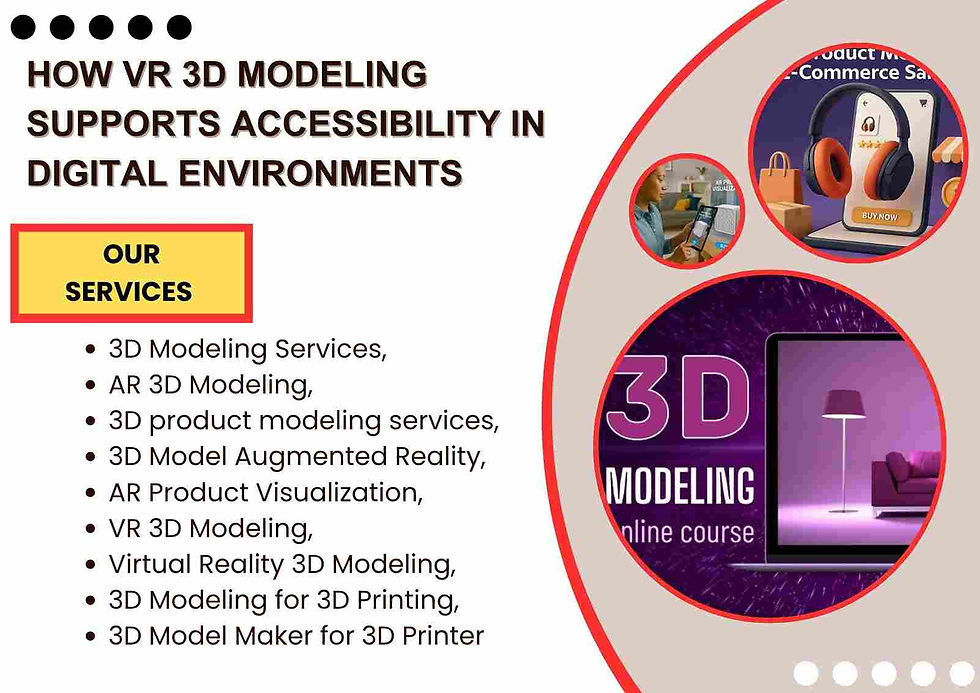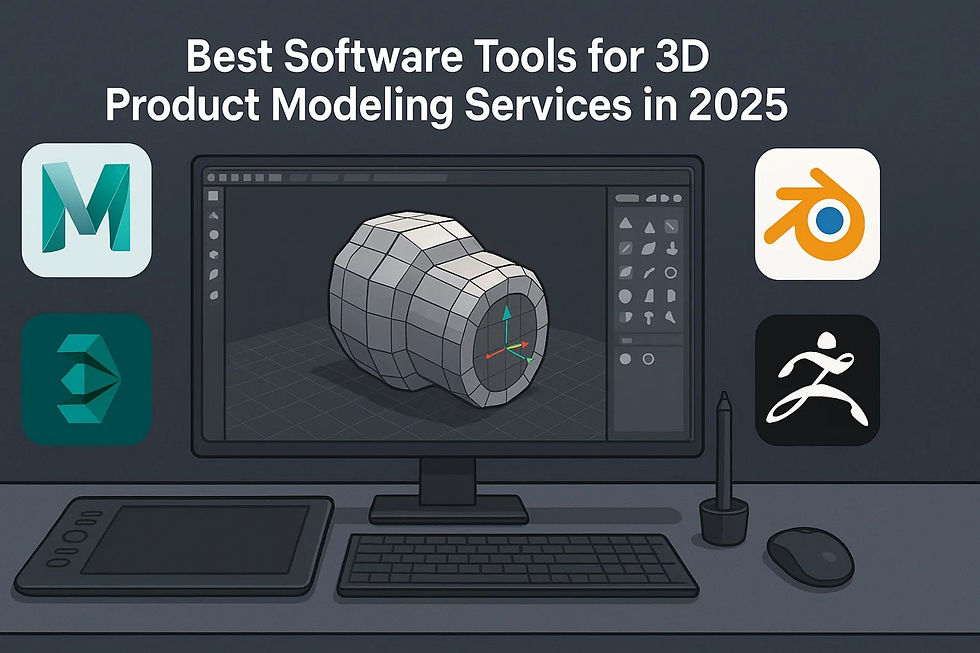How VR 3D Modeling Supports Accessibility in Digital Environments
- Hemant vizent
- Aug 4
- 5 min read

Know How VR 3D Modeling Supports Accessibility in Digital Environments
In an increasingly digital world, the concept of accessibility extends far beyond physical ramps and braille signs. As more aspects of our lives — from education and entertainment to shopping and social interaction — migrate into digital and immersive spaces, ensuring these environments are accessible to everyone, including individuals with disabilities, becomes paramount. Virtual Reality (VR) environments, once seen primarily as entertainment platforms, are now emerging as powerful tools for enhancing accessibility, and at the heart of this transformation lies VR 3D Modeling.
VR 3D Modeling is the foundational process that builds these immersive worlds, and when approached with an accessibility-first mindset, it can create digital spaces that are more inclusive, empathetic, and functional for a diverse range of users. By leveraging specialized 3D Modeling Services to construct detailed Virtual Reality 3D Modeling assets, designers and developers can proactively integrate features that break down traditional barriers, allowing individuals with various disabilities to engage, learn, and experience digital content in unprecedented ways. This shift is not just about compliance; it's about creating genuinely enriching experiences for all.
The Foundation of Inclusivity: VR 3D Modeling for Accessible Worlds
VR 3D Modeling is the core process of building virtual environments, and it's where accessibility can be integrated from the ground up, moving beyond mere afterthoughts.
Clear Visual and Auditory Cues: From defining distinct material textures (e.g., a virtual brick wall versus a smooth glass surface) to incorporating spatialized audio cues (e.g., sound of a door opening from a specific direction), VR 3D Modeling can embed redundant cues that assist users with sensory impairments.
Optimized Performance: Smooth performance is an accessibility feature. Lagging or glitchy VR 3D Modeling can induce motion sickness, especially for individuals sensitive to visual stimuli. Efficient polygon counts, optimized textures, and smart loading strategies are crucial for a comfortable experience.
Interactive Element Design: When creating interactive objects or controls within VR 3D Modeling, designers can ensure they are large enough, have clear visual feedback (e.g., highlighting when hovered over), and can be activated via multiple input methods (e.g., gaze, voice, controller buttons) to accommodate various motor disabilities.
Controlled Environments for Training/Therapy: For specific applications, such as exposure therapy for phobias or job training simulations, VR 3D Modeling allows for the creation of perfectly controlled, safe environments where parameters can be adjusted to suit individual needs, providing a tailored accessible experience.
Expanding Beyond VR: Leveraging Comprehensive 3D Modeling Services
The expertise required for accessible VR 3D Modeling often resides within specialized 3D Modeling Services firms that offer a broader range of capabilities.
AR 3D Modeling for Real-World Augmentation: While VR 3D Modeling creates entirely new worlds, AR 3D Modeling overlays digital content onto the real world. For accessibility, this could mean AR overlays providing step-by-step navigation instructions in unfamiliar physical spaces for individuals with cognitive impairments, or highlighting accessible routes in buildings for those with mobility issues.
3D Product Modeling Services for "Try Before You Buy": 3D product modeling services enable AR Product Visualization, allowing users to virtually place products (e.g., furniture, appliances) in their own homes. This is particularly valuable for individuals with limited mobility who might struggle with traditional in-store shopping, giving them the confidence to make informed purchasing decisions from home.
3D Model Augmented Reality for Contextual Information: Beyond retail, 3D Model Augmented Reality can provide contextual information overlays in public spaces, assisting users with visual or cognitive impairments.
Virtual Reality 3D Modeling for Accessible Learning: Educational institutions can commission Virtual Reality 3D Modeling to create accessible learning environments, such as virtual labs for students with physical disabilities who cannot perform certain experiments in a traditional setting, or historical site tours for those unable to travel.
Training and Empathy Building: Virtual Reality 3D Modeling can be used to create empathy-building simulations for non-disabled individuals, allowing them to experience challenges faced by people with various disabilities (e.g., navigating a public space from a wheelchair perspective), fostering greater understanding and inclusive design practices in the real world.
Prototyping Accessible Designs: Before physical construction, 3D Modeling Services can create Virtual Reality 3D Modeling prototypes of accessible building designs, allowing architects and accessibility consultants to "walk through" the space and identify potential barriers or optimize features for inclusive use.
These comprehensive 3D Modeling Services ensure that accessibility is considered across various digital and augmented platforms.
From Digital to Tangible: 3D Modeling for 3D Printing for Accessibility Aids
The 3D models created for virtual environments can also have a direct, tangible impact on accessibility in the physical world through 3D Modeling for 3D Printing.
Custom Prosthetics and Orthotics: Specialized 3D Modeling for 3D Printing allows for the creation of highly customized, lightweight, and affordable prosthetics or orthotics, tailored to an individual's unique needs, significantly improving mobility and comfort.
Personalized Assistive Devices: A 3D Model Maker for 3D Printer can design and print bespoke assistive devices – custom grips for tools, unique button overlays, or adapted interfaces – that are perfectly suited to an individual's dexterity or reach limitations.
Braille and Tactile Maps: From VR 3D Modeling data of a virtual environment, a 3D Model Maker for 3D Printer can generate tactile maps or models of specific areas, providing navigational aids for individuals with visual impairments in physical spaces.
Ergonomic Testing Prototypes: Before mass production, 3D Modeling for 3D Printing allows designers to quickly create prototypes of new accessibility aids, testing their ergonomics and functionality with real users for rapid iteration and improvement.
Educational Models for Visually Impaired: Complex scientific concepts or architectural structures, initially created through VR 3D Modeling, can be 3D printed into tactile models, offering a crucial learning tool for individuals who learn best through touch.
DIY Accessibility Solutions: The increasing accessibility of 3D Modeling for 3D Printing empowers individuals or small groups to become their own 3D Model Maker for 3D Printer, creating personalized, low-cost accessibility solutions tailored to specific, often unmet, needs.
Conclusion
By designing virtual environments with an inclusivity-first mindset, leveraging expert 3D Modeling Services to build robust Virtual Reality 3D Modeling assets, and exploring the wider applications of AR 3D Modeling and 3D Modeling for 3D Printing, we can create digital and physical spaces that truly welcome everyone. From enabling AR Product Visualization for confident online shopping to generating tangible assistive devices from a 3D Model Maker for 3D Printer, the power of 3D modeling is transforming what's possible for individuals with disabilities. As these technologies continue to evolve, the vision of a truly accessible digital environment, rich with 3D Model Augmented Reality experiences, moves ever closer to reality, fostering a more equitable and empathetic world.





Comments